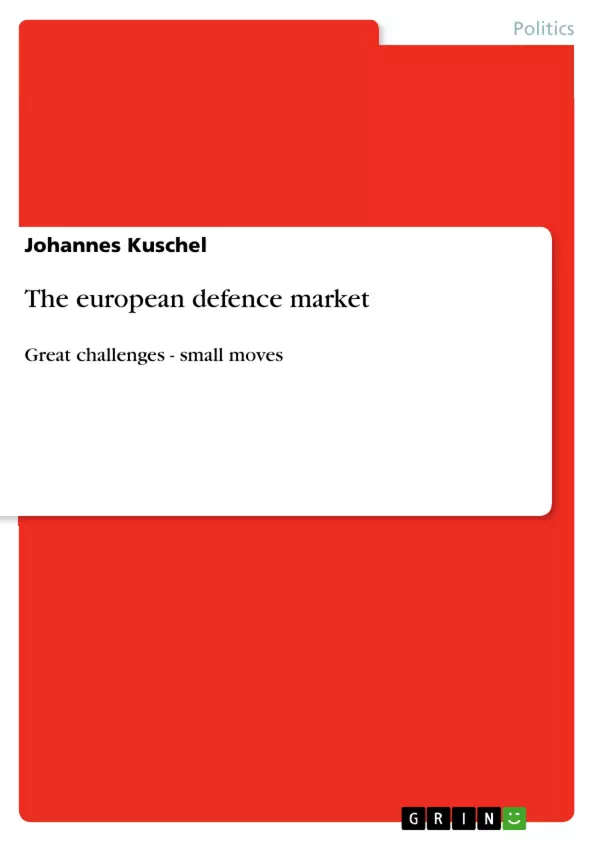This work examines the strategic options for companies in the European defence sector, taking into account the drastic changes the industry will be faced with in the coming years. It explores the players in the market, assesses their market position in their respective national industry and forecasts their potential position in a common European defence market. It explores duplication and absence of armaments and technological skills as well as the reasons for them. The paper suggests strategies to overcome the aforementioned market distortions and provides options for companies to deal with the situation favourably. Moreover, it explores the U.S. defence industry, which was confronted with severe market changes after the fall of the Berlin Wall. The research relied mainly on data issued by European Union institutions, strategic research institutions, company annual reports, international organizations such as NATO, and financial newspapers in order to cover recent events. Data was analyzed using the Herfindahl-Hirschman Index and other mainly comparative ratios in order to collate markets, companies, and structures.
The work provides an empirical analysis of market conditions that shows that European national defence markets are highly concentrated, whereas the U.S. market is unconcentrated. It illustrates reasons for this condition and presents ways to change the concentration in the market.
The research contributes towards the rather low number of studies that have been conducted in the field of European armaments. It provides a foundation for potential supplementary studies that could be concerned with an assessment of the effectiveness of legal and other initiatives used to streamline the European defence industry.
Keywords – Armaments, Market structure, Defence sector, European Union
Inhaltsverzeichnis (Table of Contents)
- INTRODUCTION
- Purpose
- Background
- Literature Review
- Design & Methodology
- Analysis
- Limitations
- Expected Outcomes
- Ethical Issues
- RESEARCH PROBLEMS
- PROBLEM 1 — Identify the key companies in the European defence sector
- Introduction
- BAE Systems
- European Aeronautic Defence and Space Company (EADS)
- Finmeccanica
- Thales
- Rolls-Royce
- DCNS - Direction des Constructions Navales Services
- SAFRAN Group
- Saab Group
- Rheinmetall AG
- Dassault Aviation
- Remarks
- PROBLEM 2 — Assess the defence companies' current position in their respective national industry and forecast their potential market power in a common European defence equipment market
- Introduction
- The task
- Limited monopsony
- The Herfindahl-Hirschman Index (HHI)
- Dispersion
- Limitations
- The British market
- The German market
- The French market
- The Swedish market
- The Italian market
- Outlook
- PROBLEM 3 — Explore duplications of armaments and technological skills within the EU, suggest strategies to reduce those and companies' options to deal with this situation
- Introduction
- Is duplication unfavourable?
- What factors led to duplication?
- The European situation (Article 296)
- Shareholding structure
- Intra-community transfers
- Juste Retour and offsets
- Examples of duplication in Europe
- Atlantic's west coast - Consolidation in the U.S.
- Legal and other counter measures to reduce and avoid duplication?
- Companies' strategies
- PROBLEM 4 — Explore absence of armaments and technological skills within the EU, suggest strategies to overcome this non-existence and companies' options to use this situation in their favour.
- Introduction
- Absence of armaments and technological skills within the EU
- Legal and other counter initiatives to reduce and avoid absenteeism
- Companies' options to use this situation in their favour
- PROBLEM 5 — Present European armaments cooperation and identify strategic options for future cooperation, merger, and acquisition
- Introduction
- The need for cooperation
- European armaments cooperation
- The future shape
- A vague strategy
- Recent developments
- Future actions
- CONCLUSION/RECOMMENDATION
- Conclusion
- Recommendation
Zielsetzung und Themenschwerpunkte (Objectives and Key Themes)
This study aims to analyze the European defence market, identifying the key companies and assessing their positions within their respective national industries. The research further examines the potential market power of these companies within a consolidated European defence equipment market. The study explores the challenges presented by duplications and absences of armaments and technological skills within the EU, proposing strategies to overcome these issues and examining companies' options to address these situations. Finally, the research explores the possibilities for future cooperation, merger, and acquisition in the European defence sector.
- Key players in the European defence market
- Market power and consolidation of European defence companies
- Duplication and absence of armaments and technological skills within the EU
- Strategies to address challenges and opportunities in the European defence market
- Future prospects for European armaments cooperation, mergers, and acquisitions
Zusammenfassung der Kapitel (Chapter Summaries)
The first chapter introduces the purpose, background, literature review, design and methodology, analysis, limitations, expected outcomes, and ethical issues surrounding the study of the European defence market. This chapter lays the groundwork for the research to be conducted in subsequent chapters.
Chapter two focuses on the key research problems, examining the leading defence companies in the European Union, assessing their market power, analyzing duplications of armaments and technological skills, exploring the absence of such skills, and exploring European armaments cooperation. Each section delves into specific aspects of these research problems, analyzing key players, market dynamics, and strategic challenges within the European defence sector.
Schlüsselwörter (Keywords)
The core focus of this work revolves around the European defence market, examining key companies, their market power, and the complexities of duplication and absence of armaments and technological skills. The analysis encompasses European armaments cooperation, future prospects for the sector, and the challenges and opportunities presented by this dynamic environment.
- PROBLEM 1 — Identify the key companies in the European defence sector
- Citation du texte
- Johannes Kuschel (Auteur), 2008, The european defence market, Munich, GRIN Verlag, https://www.grin.com/document/142183



